
Solar Mobility Act by JPods
Pitch
Laws favor oil/coal fired transport/utilities. Solar Mobility Act restores free markets, allowing cleaner, faster, safer, cheaper networks.
Description
Summary
Vulnerable communities should save money by specifying a regulatory framework that allows private capital to fund deployment of solar-powered mobility networks to displace coal/oil fired highways and mass transit.
Solar-powered mobility networks are 10 to 100 times more efficient than government oil-powered networks. Efficiency equates to pollution and cost per unit of economic work. Following is a graph of cost/pollution per passenger-mile (data sources: cost per passenger-mile is Massachusetts DOT, energy/pollution per passenger-mile is US DOE):
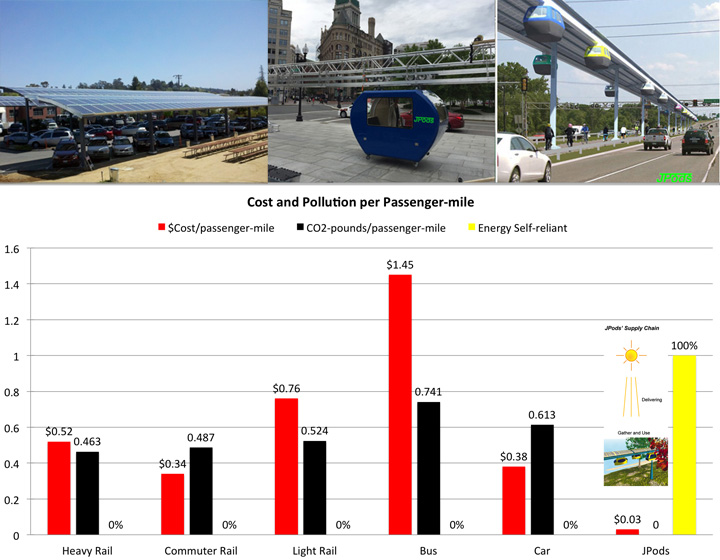
Solar-powered mobility networks can easily compete with government monopoly protected oil/coal fired networks.
The Solar Mobility Act:
THEREFORE, BE IT RESOLVED,
Non-exclusive access to rights-of-way governed by this jurisdiction will be granted to transportation systems providers meeting the following free market principles:
- Privately funded construction, and;
- Privately operated without government subsidies, and;
- Exceed 120 passenger-miles per gallon, or equivalent efficiency, and;
- Exceed safety performance of transportation modes already approved for use, and;
- Gather at least 2 megawatt-hours of renewable energy per average mile of network per typical day.
THEREFORE, BE IT FURTHER RESOLVED, Regulation of free market innovations shall be based on:
- System design, fabrication, installation, safety, insurance, inspection practices shall be compliant with the ASTM International, Committee F24 on Amusement Rides and Devices, and;
- Environmental approvals will be granted based on a ratio of energy consumed per passenger-mile of the innovation versus transport modes approved to operate in the rights-of-way, and;
- All taxes and fees assessed on the transport systems providers, passengers and cargo shall be limited to 5% of gross revenues and paid to the aggregate rights-of-way holders by transportation systems providers, and;
- Specific networks franchises will be governed similar to how communications networks are governed.
What actions do you propose?
Action: Pass the Solar Mobility Act
Pollution is a consequence of government monopoly protection of oil/coal fired infrastructure. These transport networks generally require moving two tons to move a person. The pollution from burning energy to move two tons to move a person tilts the balance of nature into Climate Change.
The Solar Mobility Act applies to anyone who can build infrastructure 5 times more efficient than highways. JPods' data is used for examples because our team understands it.
Communications Infrastructure as a Model:
The potential for communication innovation was well understood with car radio telephones in 1924, and Nikola Tesla’s summary of the Internet in 1926:
- "When wireless is perfectly applied the whole earth will be converted into a huge brain, which in fact it is, all things being particles of a real and rhythmic whole. We shall be able to communicate with one another instantly, irrespective of distance. Not only this, but through television and telephony we shall see and hear one another as perfectly as though we were face to face, despite intervening distances of thousands of miles; and the instruments through which we shall be able to do his will be amazingly simple compared with our present telephone. A man will be able to carry one in his vest pocket.”
Patents for WiFi and BlueTooth technologies were filed in 1941. In 1968, there was the Mother of All Demos. The technology existed to build the Internet but was prevented from commercializing for decades under Federal monopoly. Governments coerce compliance with law. Innovation is a disruptive compliance failure. As current laws suppress for Creative/Destruction of oil/coal-fired networks, the Federal communications monopoly suppressed network innovation.
The unconstitutional Federal communications monopoly stifled these innovations in the near century of rotary telephones. In 1982 liberty was restored with the Federal communications monopoly being declared unconstitutional. Millions of jobs were created innovating better services at lower costs once the Rule of Law was restored.
Removing Federal monopoly protection of communications infrastructure provides a model of what will occur once government monopoly protection of transport/power infrastructure is removed.
It is the nature and just purpose of government to coerce compliance with laws. Innovation is a disruptive compliance failure. The shift from a century of rotary telephones under Federal monopoly to smartphones today illustrates why governments should be limited to apply police powers to punish bad behaviors, not limit innovative ideas.
Liberty is society's tolerance for disruptive minorities. There is no minority as tiny and disruptive as commercial innovators. The fact that we know the names of Ford, Edison, Bell, the Wright Brothers, Bill Gates and Steve Jobs underscores how tiny this minority is.
The book, Why Nations Fail, the origins of power, prosperity, and poverty provides brilliant examples of why "inclusive institutions" (liberty) produce wealth. "Extractive institution", such as the government oil/coal powered infrastructure monopolies result in depletion and poverty.
Liberty is the source of the "general welfare".
As the Federal communications monopoly was declared unconstitutional in 1982, Federal taxing and monopoly protection of oil/coal fired infrastructure is unconstitutional. Here is a link to five Presidential vetoes explaining the Constitution and eight Presidents declaring the consequence of violating the Constitution. Dependence on energy outside self-reliance is Illicit Energy. Federal support for foreign oil and Federal support for slavery are examples of Illicit Energy. These policies build the same path to war. Oil-wars since 1991 indicate the building path to war as the Joint Forces Command warned all US military commands in 2010. Oil-wars, debt, and Climate Change are facets of the same infrastructure policies. Documentary from ABC Australia, 2005.
Change the policies, and we preempt the cause of war and Climate Change.
Vulnerable communities have sovereignty over their roads and can pass the Solar Mobility Act to restore liberty to deploy cleaner, faster, safer, and more affordable mobility networks.
New Policies
The Solar Mobility Act sets policies based on what society needs; it is about "what" not "how". It calls for using the police powers of government to direct industry to increase efficiencies 5x, five times better.
Current policies collect taxes to fund what the Governing perceive are the solutions. Yet those solutions protect from competition the oil-fired infrastructure causing Climate Change. As an example of the current policy defect, buses, per passenger-mile, cost $1.45 and produce 120% of the CO2 of cars. By contrast, the Personal Rapid Transit (PRT) in Morgantown, WV has been oil-free and injury-free since it opened in 1975.
Congressional Office of Technology Assessment study PB-244854, published in 1974 warned of "institutional failures" as the likely reason Personal Rapid Transit would not be adopted to make American cities independent of foreign oil. Climate Change is a consequence of governments protecting oil/coal fired infrastructure from competition by cleaner, faster, safer, and more affordable mobility networks. Despite averaging 476 ton-miles per gallon, nearly half the freight railroads in the US have been driven into bankruptcy/abandonment. American governments' hostility to biking is another example.
Governments around the world have followed the American example since World War II. The Solar Mobility Act allows vulnerable societies to use the police powers of their governments to set "what" society needs, not tax to subsidize "how" Climate Change was caused.
Progress is being made in several nations:
After an 8-year effort to deploy Personal Rapid Transit networks in Boston, Massachusetts Senate Bill 1837 was filed in 2015. In 2016 the Legislature killed the bill. Here is a link to the Oct 2015 hearing with Boston City Council. The Solar Mobility Act has been resubmitted to the 2017 Massachusetts Legislature:
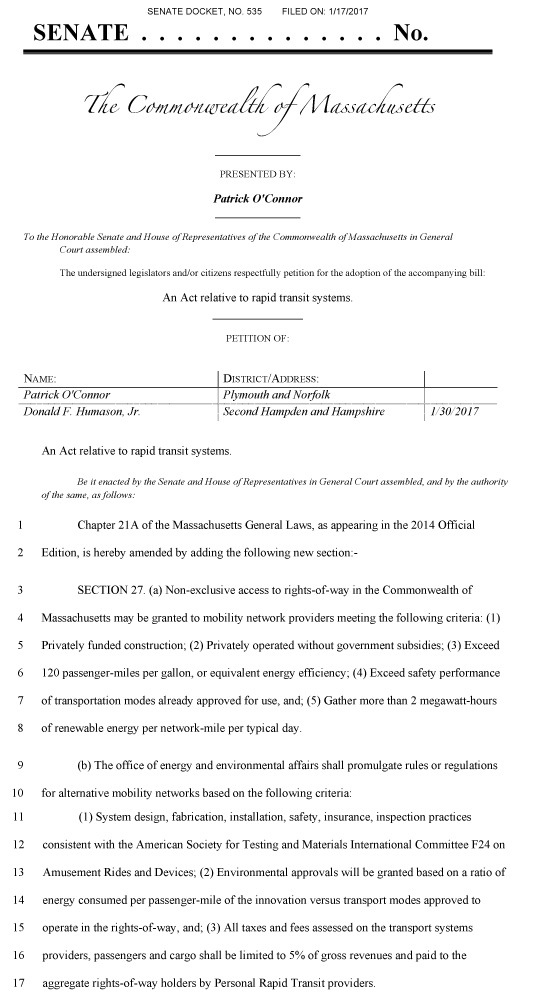
With liberty to innovate restored, with oil/coal fired monopolies broken, we will change the lifeblood of society from oil to ingenuity as Thomas Edison noted was practical in 1910:
"Sunshine is spread out thin and so is electricity. Perhaps they are the same, Sunshine is a form of energy, and the winds and the tides are manifestations of energy.”
“Do we use them? Oh, no! We burn up wood and coal, as renters burn up the front fence for fuel. We live like squatters, not as if we owned the property.
“There must surely come a time when heat and power will be stored in unlimited quantities in every community, all gathered by natural forces. Electricity ought to be as cheap as oxygen...."
Evolution of Behavioral Norms
Theme Park are model cities, designed for pedestrians, especially children. There are powerful thrill rides, yet the safety record is 4.5 injuries per million. Management and engineering decision focus on producing value.
In contrast to management and engineering decisions by theme park people, government transportation monopolies protect their networks from competition with a road-death rate of 106 per million. Unlike Theme Parks, sovereign immunity protects bad government policies and their decision makers from accountability.
The Solar Mobility Act set new norms for management and engineering decisions based on safety and efficiency. The Theme Park standards are selected for several reasons beyond the 4.5 injuries/million versus 106 deaths/million safety record of DOTs:
- Capital will not invest in innovative transportation networks without a well know cost of regulation. Theme parks have a well-understood record of innovation and safety.
- There is an existing enforcement industry.
- There is an existing insurance industry.
- There is existing common law. Innovative networks will not and should not be protected by sovereign immunity.
- Theme Park standards are policed by a different agency in governments than Departments of Transportation. Setting up competition between government agencies ends the current monopoly, setting up checks and balances within governments.
With a known, well established, and fun regulatory environment, capital and innovators will invest money and time to convert the per-passenger-mile cost of buses of $1.45 to $0.03 cents. It will become a behavior norm to design systems around people instead of buses and cars.
It is profitable to preempt the causes of Climate Change.
The Physical Internet®:
Just as the potential for the Internet was understood long before the Rule of Law was restored, radically safer, more efficient, and more profitable transport networks are well understood:
- The 140,000 miles of freight rail in the US average 476 ton-miles per gallon. Freight rail is 140 times as efficient as moving a ton to transport a person on highways and mass transit. Since the Federal-Aid Highway Act of 1956 removed efficiency as a market force, nearly half the freight rail in the US has gone bankrupt or been abandoned.
- The Personal Rapid Transit (PRT or podcar) network in Morgantown, West Virginia has delivered 110 million oil-free and injury free passenger-miles since it was built as a solution to the 1973 Oil Embargo. In the same period that PRT has been injury-free, 1.7 million American were killed on the nation’s roadways. Reference: (1 minute video, 17 minute video on benefits from the 1977 Congressional Office of Technology Assessment study PB-244854 about how Morgantown’s PRT can make American cities independent of foreign oil, 1974).
- Theme Parks are model cities designed for pedestrians. The 294 million visitors per year experience an injury rate of 4.5 per million. In contrast, DOT engineered systems kill 10.6 people per 100,000 each year.
- Kiva System, now Amazon, is applying digital robot transport networks in warehouses with a 20x return on capital.
Economic Incentives:
Pollution is an indicator of costs not recovered as value. With free markets restored, profit seekers will aggressively work to convert pollution costs into profits. Human nature is leveraged.
Evolution of Behavior Norms:
Transportation has always been the catalyst for changing energy systems.
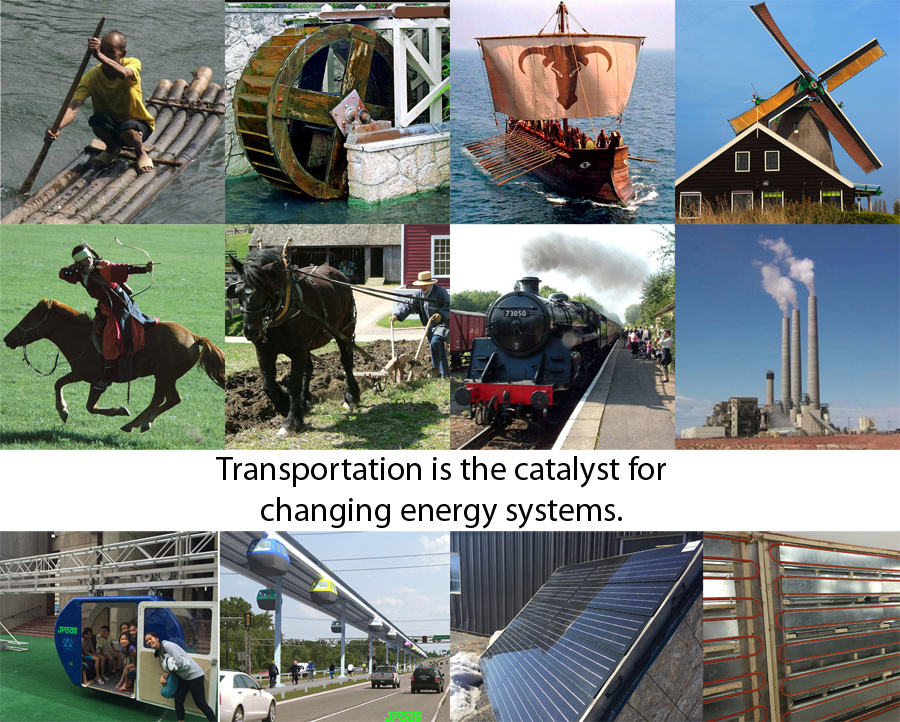
Norms shift base on increased value at lower costs:
- Paddle a raft, build a waterwheel.
- Sail a boat, build a windmill.
- Ride a horse, harness a horse to a plow.
- Railroads in the 1860s were the catalyst for
 changing the energy system from biofuels to fossil fuels. In current dollars, oil cost near over $50 a barrel in 1860. After vast deforestation, railroads tuned their engines to burn coal and oil. Railroads used their reduced cost of transport to haul coal and oil to new markets.
changing the energy system from biofuels to fossil fuels. In current dollars, oil cost near over $50 a barrel in 1860. After vast deforestation, railroads tuned their engines to burn coal and oil. Railroads used their reduced cost of transport to haul coal and oil to new markets.
Passing the Solar Mobility Act will likely allow solar-powered mobility networks to change the lifeblood of economies from oil to ingenuity. Solar is 6x (6 times) less expensive as a transportation fuel than oil based on Net Energy. Link to Energy Economics summary and link to transportation energy metrics.
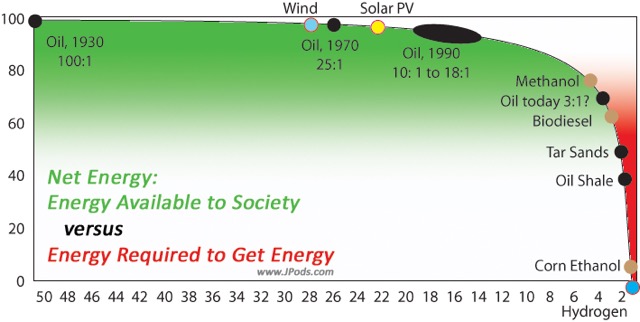
Solar collectors designed to gather energy over transport networks gather 4 to 6 megawatt-hours per mile of rail per day. Solar farms should be built over deserts; city streets are deserts. Here is a photo of collector systems by Swenson Solar designed to go over solar-powered mobility networks. They are deployed in a parking lot because the City of Santa Cruz, CA talks about Personal Rapid Transit networks for decades but blocks deployment because they do not know how to regulated them. Passing the Solar Mobility Act would create a regulatory framework.
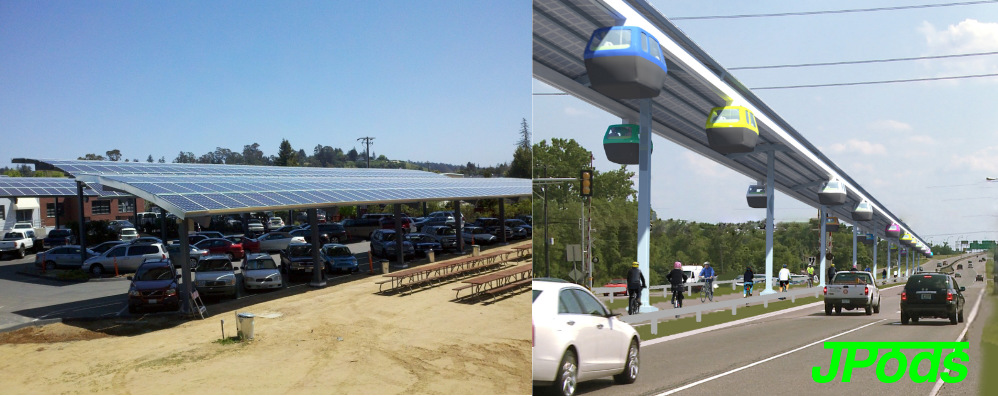
In addition to much lower energy per unit of economic work, the capacity of solar-powered networks is radically higher. Each rail has the carrying capacity of a 12-lane highway at 35 mph.
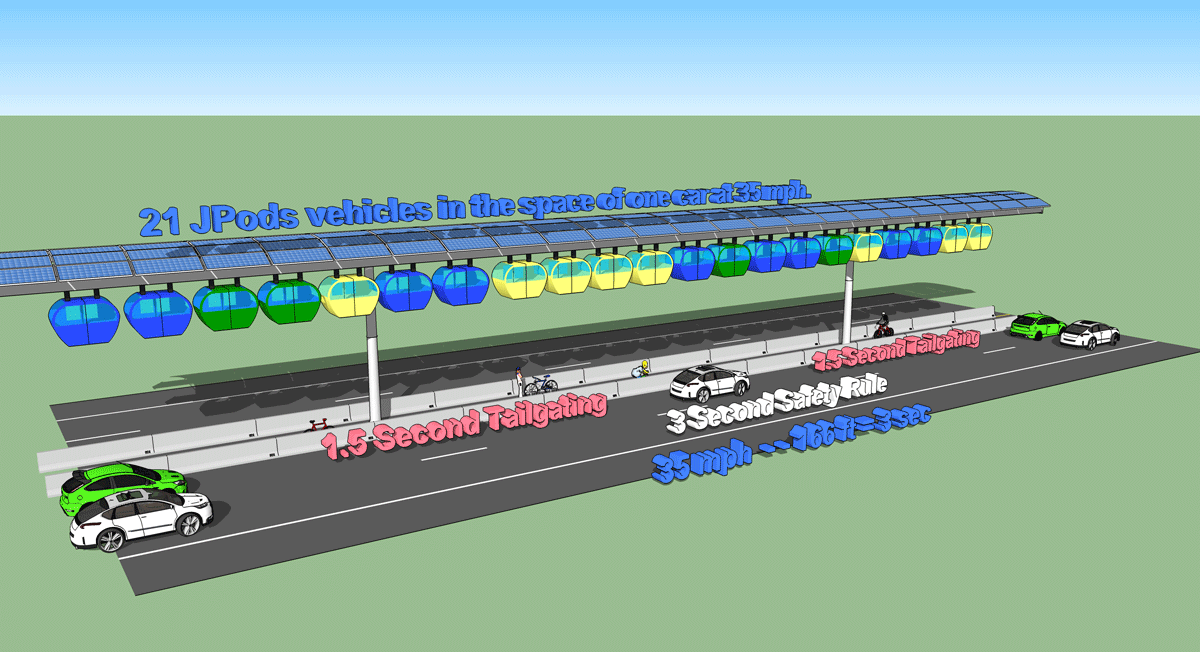
Another norm we believe will also change is the money will become backed by energy. Life requires energy.
Who will take these actions?
Governments that have sovereignty over roads will need to pass the law to allow alternative networks to use Rights of Way.
Once the Solar Mobility Act removes government monopoly protection from oil/coal fired highway and mass transit networks, a wave of innovation will follow.
Private Capital:
The 20x return on capital of Kiva Systems indicates how private capital will invest to profit from converting pollution into value.
Commercial Innovators:
A number of private companies are staged to begin building the Physical Internet:
- SkyRide Technology has installed a system on the Carnival Vista 2016 ship and a second order by Carnival has since been placed.
- Hyperloop has come to agreements in Dubai.
- JPods recently signed agreements for funding in China and India.
- ET3, Taxi2000, Metrino, SkyTran, and several others will begin building as soon as the government monopoly that caused the loss of half the freight rail in America is broken.
As with the Internet in 1982, many more innovators will enter the market once oil/coal monopoly protections are removed.
Customers:
People will pay for cleaner, faster, safer, and more affordable mobility networks. Human nature supports collaboration.
Customers will shape the speed and extent of network deployment. The greater to value recovered by the customer, the more willing the customer will be to pay to have the networks replace their cars.
Liberty, Source of the "general welfare":
The Solar Mobility Act restores liberty. Liberty is the source of the "general welfare" as two facets intertwine in a Darwinian crucible:
- Liberty is society's tolerance for disruptive minorities. Commercial innovators are a tiny and very disruptive minority. They offer a radical change from the past.
- Liberty to chose in free markets. The aggregated wisdom of all of us, with each acting in our own self-interest is wiser than the wisest of us at choosing between choices.
- Two books: The Wisdom of Crowds and Why Nations Fail, Origins of Power, Prosperity and Poverty.
Where will these actions be taken?
Actions will occur everywhere political leaders are willing to restore free markets. Most cities will benefit from solving traffic congestion.
Climate Change is a global consequence of the local problem exemplified by traffic jams. Remove the traffic jams and you preempt the cause of Climate Change.
What are other key benefits?
Most of the networks deployed after the Solar Mobility Act is adopted will be grade separated (elevated). Benefits likely are:
- Solar collectors deployed over the networks will gather about 5 megawatt-hours per mile per day (40,000 vehicle-miles per mile per day). This will make the networks durable against oil supply shocks.
- A large stable market will be created for solar.
- Traffic deaths and injuries will be dramatically reduced.
- Flooding will be mitigated.
What are the proposal’s costs?
There is a 10x cost savings in converting pollution, congestion, accidents into value. Private capital will invest to profit once government protection of oil powered infrastructure ends, as with communications.
Again, Kiva Systems provides a 20x Return on Capital example of the value to be expected. Uber, Lyft, and self-driving cars are generating capital by applying better communications networks to the analog highway.
Urban network examples of the Return on Investment are:
- Morgantown, WV Personal Rapid Transit (PRT) network. It as delivered 110 million oil-free, injury-free passenger-miles since it opened in 1975. In 2010 a financial audit showed it paid for itself every five years.
Wuppertal's suspended train carries about 25 million passengers per year. Since starting operations in 1903, there has been one fatal crash.
About 90 cents of every dollar currently spent on traffic is recoverable as profit or customer savings base on Massachusetts DOT cost data per passenger-mile:
- $0.76 for light rail
- $1.45 for buses
- $0.38 for cars
- $0.03 for solar-powered mobility networks (JPods data).
The race to convert costs into profits will be intense. Networks will start in niches, such as connecting airport terminals to parking to hotels to car rental. Payback in such niches is less than 3 years.
On the macro scale, the market size in the US is about 500,000 mile, or 25% of the lane miles of urban roads. At $10 million per mile, the cost of these networks is $5 trillion. It will take 10 to 20 years to build these networks, but if they could all be built today, the payback would be less than 5 years based on:
- $250 billion per year spent buying foreign oil.
- $400 billion per year by cutting accident costs in half.
- $300 billion per year by cutting defense of foreign oil by half.
- $100 billion per year by cutting traffic congestion by 90%.
It is extremely expensive to move two tons to move a person. Government monopolies that require such waste will be broken by the Solar Mobility Act.
Time line
Once the Solar Mobility Act removes monopoly protection of oil/coal highways and mass transit networks there will be a race to convert costs into profits.
The race will likely look like the Long Waves of past network displacements:

The Internet and cell networks deployed faster than these long waves because natural progression had been stifled by government monopolies. Perhaps the Physical Internet will also deploy more quickly once monopoly protections are removed.
It is highly likely that by 2019 depleting US oil production will force a desperate effort to speed deployment of sustainable mobility networks. Life requires energy. Cheap oil is finite. In 2008 US energy production dropped to the point the economy nearly collapsed. That situation will likely repeat by about 2019.

Climate Change should be equated to gasoline prices. US Peak Oil in 1970, resource depletion, $20 trillion in Federal debt increasing in tandem since US Peak Oil, oil-wars since 1991 are all facets of a single defect: Federal oil/coal mandated infrastructure.